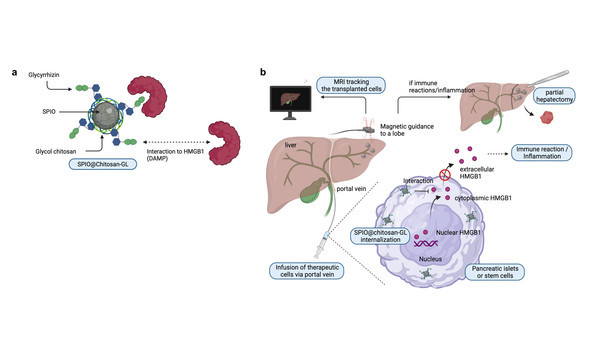Injecting biological material into conventional contrast agent to relieve immune inflammation…Increasing the possibility of successful cell transplantation
Hanyang University announced on the August 9th that professor Lee Dong-yun's research team from the department of Bioengineering developed a therapeutic contrast agent that suppresses immune inflammation in the cell transplantation field. Professor Lee’s team developed a contrast agent that can control immune inflammation by applying biomaterials that inhibit immune inflammatory response-inducing factors to the contrast agent used in MRI scanning to make the tissues and blood vessels more visible.
The contrast agent developed by the research team can be absorbed into the (stem) cell therapy for transplantation without toxicity and control the immune inflammatory response of the cell transplant site, maintaining the same function as the conventional contrast agent. This can maximizes the therapeutic efficacy of cell therapy, which is expected to be used in various cell transplation fields in the future due to the wide range of applications.
Type 1 diabetes treatment refers to a treatment method in which pancreatic cells secreting normal people's insuline are transplanted into liver of diabetic patients. However, many cases of reduced treatment effect have been reported due to the immune responses and immediate blood-dediated inflammatory reactions (IBMIR) in transplated patients.
These immune rejection and inflammatory reactions are caused by DAMP(damage-associated molecular pattern) molecule of the transplanted cell. Professor Lee’s team established a hypothesis "Controlling the DAMP molecule which hugely impacts early immune rejection and inflammatory reaction will enable successful cell transplantation treatment" and devised the treatment.
Following the hypothesis, the research team developed a new contrast agent by coating nano molecules with glyciridine-glycol chitosan that represses HMGB1(High mobility group box-1), one of the main DAMP molecules, and confirmed the inflammatory reaction was alleviated.
In the subsequent experiment, the research team confirmeded that type 1 diabetic animal model showed repressed immune reaction for a long period of time (one month) when pancreatic cells and mesenchymal stem cells were injected in the animal model. In addition, the they can monitor the position and status of transplanted cells for a long period through MRI.
This research is meaningful in that the developed constast agent to control immune inflammation can be applied and used not only in pancreatic cells for type 1 diabete treatment but also in various cell transplantation fields which have not had good results due to the immune rejection and inflammatory reaction.
This research was supported by the Korea Health Industry Development Institute in the Ministry of Health and National Research Foundation in the Ministry of Science and ICT, which was published in 「Biomaterials (IF=15.304)」, a world-class journal in the field of medical life and medical engineering in early August.
The paper (title : DAMP-modulating nanoparticle for successful pancreatic islet and stem cell transplantation) was written by the first co-authors: Doctor Kim Hyeong-sik of Hanyang University Department of Bioengineering, Master’s degree Jang Soo-bin and Jin Sang-man professor of Samsung Seoul Hospital and by corresponding authors: Lee Dong-yun professor Hanyang University and Kim Jae-hyun professor of Samsung Seoul Hospital.

Click to see the paper:
키워드
 '한양위키' 키워드 보기
#SDG3
'한양위키' 키워드 보기
#SDG3

